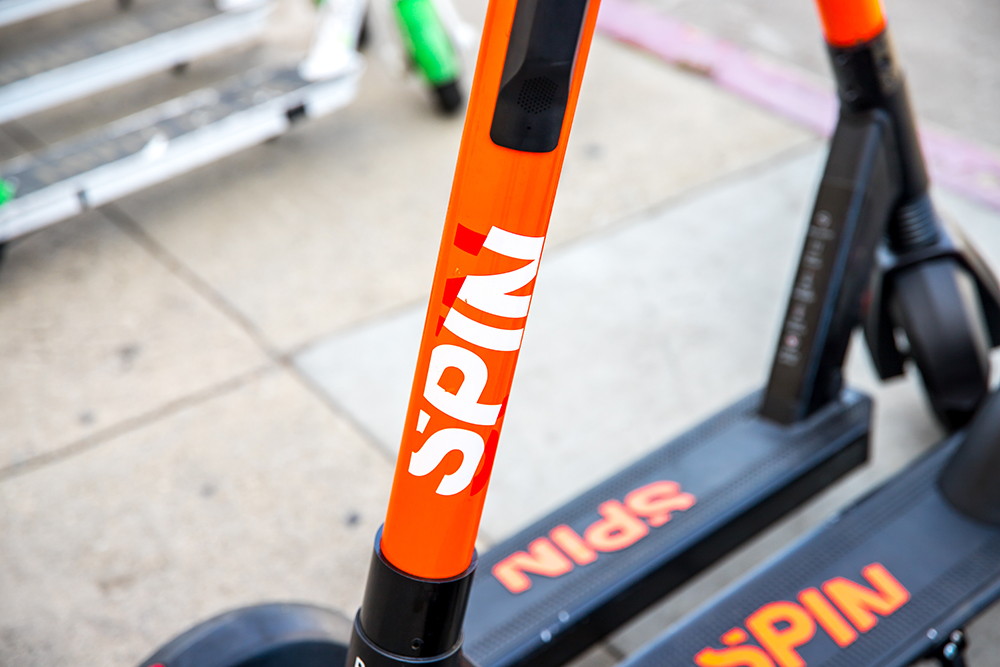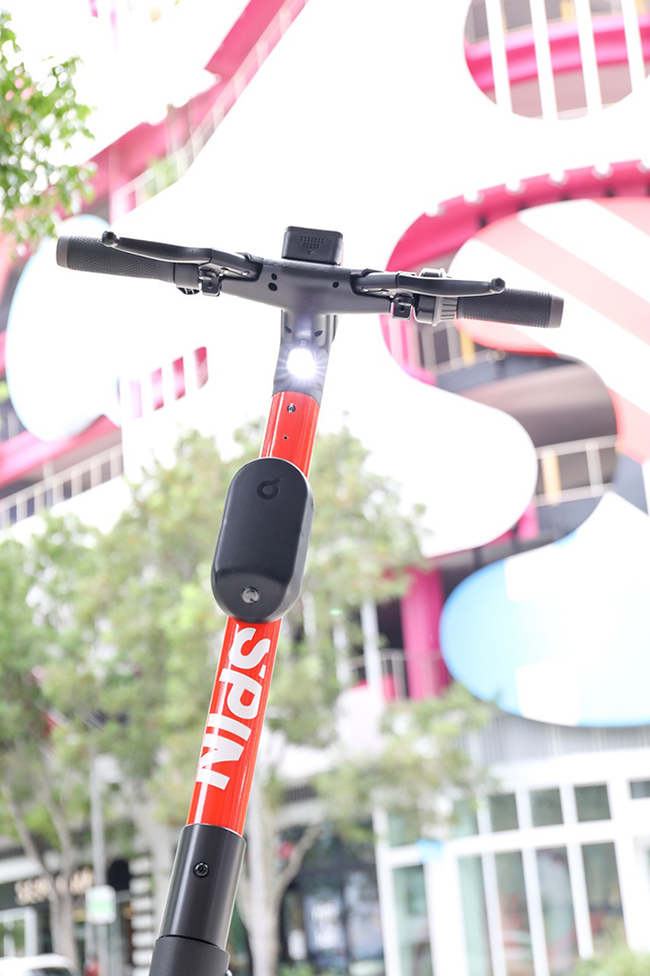
Alex Nesic, co-founder of Drover AI, apologises for being a few minutes late to call from Los Angeles. An investor meeting overran: Drover AI is attracting admiring glances for its core product, PathPilot, which aims to prevent e-scooter users from riding where they shouldn’t and from dumping their vehicles where they mustn’t. As cities worldwide tighten up on how many micromobility firms can operate in their environs, this sort of tech may provide crucial differentiation for scooter operators.
PathPilot is, in essence, a classic ‘little black box’ which can be retrofitted onto any micromobility vehicle, although the company has targeted e-scooters first. “It is a secondary IoT [Internet of Things] module,” explains Nesic. “All of these free-floating devices have to have an IoT module that, at the very least, leverages cellular connectivity and GPS to be able to track and manage these assets and for customers to be able to interact and rent them.”
PathPilot also has GPS and cellular – but there is one crucial addition. “It’s the first one to bring a camera and edge-based processing on board to run our AI algorithms, which do what regular IoT and GPS cannot do,” he continues. “We are setting the lead in this race, I would say. We are the only company currently deploying computer vision at the edge, with deep learning, to deliver the kind of functionalities that we deliver for our customers. We’re certainly not the only ones that are messing around with this technology, but we’re the only ones currently at scale with a product that is mass-produced, deployed in close to a dozen markets and over 2,500 devices to date, with orders on hand for thousands more.”

In the US, the vast majority of the scooters that have been retrofitted with the gizmo are owned by Spin – and he says Spin’s win-rate is “above 95% on RFPs that include our technology”. (Nesic is speaking to ITS International a few weeks before Tier Mobility announced its takeover.)
He sets out the advantages of PathPilot. “The way I break it down is as follows: off-the-shelf GPS fails in dense urban environments because it’s trying to solve for precise position, a coordinate-based position,” he says. “It’s looking for latitude/longitude with the least amount of margin for error. Off the shelf, you have somewhere between a 30- and 100-foot margin of error; if you enhance it, there are claims that you can get to within 10cm accuracy.”
That’s “very unlikely” in a dense urban environment, he says. “What we do is that, with a camera and our algorithms, we don’t care about GPS in that context, or cellular availability, because it’s all happening on the edge and our system enables a device to position itself much more like a human does.”
By this he means: as humans, we don’t go into the street and wonder what our exact coordinates are – we position ourselves in a way that we see is appropriate to our surroundings. “We call it contextual location awareness,” explains Nesic. “We see that the sidewalk is where it is, that it ends where it ends, that then there’s the bike lane, and then the street beyond it. And so we’ve trained our system, our algorithms, to recognise several pre-defined categories - streets, sidewalks and bike lanes being the three principal ones.”
So the technology is all well and good – but how does PathPilot actually prevent scooter riders from becoming pavement terrors? Above a certain speed, it detects when you’re somewhere you shouldn’t be and enables real-time notification through a speaker in the black box; this can be a sound or a voice message telling you that you’re in the wrong place. If that doesn’t work, there is more drastic action. “We can also integrate with the vehicle at the edge to slow it down or disable it in real time - within two seconds of the infraction happening,” Nesic says. “It’s a dynamic way to manage how these devices move in a context where many times riders either don’t know the rules or don’t care to follow the rules.”
He emphasises it is not Drover AI which disables the vehicle: “The decision at that point to take action over the scooter itself is not ours, it is the operator’s. And it’s going to be in response to existing regulations or the competitive environment: if you’re the only one slowing scooters down in an environment where nobody else is doing it, the consumer is going to pick somebody else’s device – there are no delusions there. The regulatory environment is the ultimate decider of whether scooters get slowed down or disabled on sidewalks or the behaviour that needs to be enforced. We simply enable it.”
But the ‘nudge’ effect of playing a customisable warning sound or a phrase in different languages is a little like the seatbelt chime in a car, he thinks. At the moment, scooter operators do attempt to influence the rider to do the right thing before and after their ride. “You open up your app, and it says ‘please, these are the rules: don’t ride on sidewalks, don’t do X,Y and Z’ and people just swipe swipe, swipe, ignore, ignore, ignore,” Nesic says. “There may be a placard on the scooter itself that says ‘don’t ride on sidewalks’ - ignore that. And at the end of the ride, if the operator has some idea of whether you rode on the sidewalk or not, they might give you a message that says ‘hey, we think you rode on the sidewalk last ride - please don’t do that again’. Imagine if your car behaved the same way to try to get you to put your seatbelt on? People wouldn’t be putting their seatbelts on! But if you get in your car and you don’t put your seatbelt on and the thing won’t shut up, you eventually put your seatbelt on because your sanity is at stake, right?”
Parking validation
Audible feedback has a dual purpose, since many accidents with scooters occur on sidewalks, according to a study by the US Insurance Institute for Highway Safety. “A big part of that is that these are silent and so you get caught off-guard as a pedestrian,” he continues. “If somebody is flying down there at 10-15mph, it’s going to be a problem. Even if you’re not slowing a scooter down, having a persistent sound that is not in the control of the user is going to warn bystanders that something is coming and avoid a lot of bad outcomes.”

At slower speeds, PathPilot can do something else: parking validation, which Nesic says is the “second-biggest burden of free-floating micromobility”. Scooters get left in the middle of the sidewalk, creating a very real trip hazard for people with visual disability or a problematic obstacle for vulnerable groups such as the elderly. Drover AI’s algorithms look for three ‘valid’ places to park a scooter: “One is within approximately half a metre of the edge of the kerb, the outer edge of the sidewalk; two is within about half a metre of bike racks or biking infrastructure; and the third is within a designated micromobility corral,” explains Nesic.
Therefore the system decides what’s a fair place to leave a scooter and what’s not, putting an end to scooter operators asking users to submit a cellphone picture to show where they’ve parked at the end of a ride – only around 20% of which are ‘actionable’, Nesic says. “Often it’s pictures of the feet or somebody’s pocket, sometimes less savoury things! But the other dirty secret of the business is that the operators themselves don’t really look at the pictures; there’s nobody on the other side going ‘oh yeah, this is a good parking job’. And so we create a technology that gives you 100% insight - good, bad or indifferent - into the ‘end of ride’. We pair a photo with each end of ride along with our AI score, and we can escalate certain outcomes that are extra bad, like if you’re parked in the middle of a kerb cut-out that has a rumble strip or if it’s in the middle of the crosswalk.”
This is what Nesic terms “proactive compliance” rather than waiting for an incensed local to report pavement clutter or for your street team to happen upon it.
Nesic suggests that PathPilot has struck a chord because it is addressing existing regulatory requirements. “It’s already illegal to block the right of way because of legislation like the Americans with Disabilities Act, which has been around for over 30 years and adopted by 180 countries to some form or another,” he says. “And it’s already illegal to ride on sidewalks, or pavements in 95% of jurisdictions where this technology is. So we really fit nicely in that context, because we allow cities to tick that box off in terms of safety and not exposing themselves to potential litigation, and risk, and unpleasant outcomes, with these new modalities co-mingling with pedestrians. But it also enables the more rapid growth of micromobility because cities can say: ‘We’re not going to limit you to just 500 or 1,000 units. Because it can be done with a more proactive compliance effort, we’re going to increase the fleet allocation’ and that helps our customers. So there’s different things at play.”
Transitional period
Pedestrians sometimes feel a little overlooked in the micromobility debate; scooter riders might crash into a tree or hit a pothole but they’re making an active choice to ride – pedestrians who get injured by scooters are not making that same kind of choice. In this context, PathPilot could be seen as a rebalancing to some extent.
“I think that’s an astute observation,” he says. “We’re in a transitional period. So in the absence of adequate infrastructure for each and every modality that might exist, you have interaction between each and it’s unfair to ask the scooter rider to feel comfortable in sharing space with a 5,000-pound vehicle going 45mph or more. But by the same token, if they ride on the sidewalk because they don’t feel comfortable with that interaction, they then become a threat to the pedestrian – who is walking about three-and-a-half mph and doesn’t want to deal with somebody going 15mph.”
Cities are responding: by the end of this year, Nesic hopes to have 40-50,000 devices in the field. Outside the US, Drover AI has pilot projects in south-east Asia, Australia, New Zealand, the Middle East and Europe (where it has an agreement with Voi).
“The pandemic created a vacuum and a lot of fleets had to downsize,” he says. “But also cities started becoming much more prescriptive about how many operators could deploy, and how many devices can be deployed even within specific zones in the city, so you’re seeing basically more management - because at the outset, cities were just saying: ‘Alright, come one, come all’.”
Looking back, the numbers are mind-boggling: by the end of 2019, around 36,000 scooters were estimated to be registered to companies in Los Angeles alone.

“That was an oversaturation, and it led to really kind of sloppy, mountains of scooters in certain areas,” he says. “And so now through GPS geofencing, the city has these dashboards that they can manage in real time to say: ‘Hey, you have an overabundance of scooters in this particular quadrant, you need to rebalance them and move them to a different service area’.”
It’s a fine balance, he acknowledges. “Because you want to have enough free-floating assets that they’re convenient to find, but not too many that they become a burden to other modalities.”
As cities move from an ‘open house’ view of attracting micromobility operators to a more competitive permit environment, Nesic suggests – unsurprisingly - that tech will be the big differentiator. He cites the example of Spin in Santa Monica, which used PathPilot to slow scooters on sidewalks and won the licence to operate. There will be more of that in future city RFPs, he says.
“Think about it this way: if there are three slots open for a competitive permit, and 15 companies are applying, you’ve got to do more than just be a different colour than your competitor; without being glib, that’s basically the difference between scooter operators unless you introduce a technology like ours.”
And there is a long way to go in this journey. “We’re not even on the ground floor – we’re still in the basement level of micromobility,” Nesic smiles. ITS





